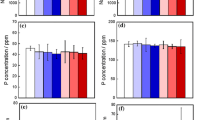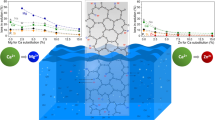Abstract
In this paper, we investigate the effect of substituting SrO for CaO in silicate and phosphate bioactive glasses on the human gingival fibroblast activity. In both materials the presence of SrO led to the formation of a CaP layer with partial Sr substitution for Ca. The layer at the surface of the silicate glass consisted of HAP whereas at the phosphate glasses it was close to the DCPD composition. In silicate glasses, SrO gave a faster initial dissolution and a thinner reaction layer probably allowing for a continuous ion release into the solution. In phosphate glasses, SrO decreased the dissolution process and gave a more strongly bonded reaction layer. Overall, the SrO-containing silicate glass led to a slight enhancement in the activity of the gingival fibroblasts cells when compared to the SrO-free reference glass, S53P4. The cell activity decreased up to 3 days of culturing for all phosphate glasses containing SrO. Whereas culturing together with the SrO-free phosphate glass led to complete cell death at 7 days. The glasses containing SrO showed rapid cell proliferation and growth between 7 and 14 days, reaching similar activity than glass S53P4. The addition of SrO in both silicate and phosphate glasses was assumed beneficial for proliferation and growth of human gingival fibroblasts due to Sr incorporation in the reaction layer at the glass surface and released in the cell culture medium.








Similar content being viewed by others
References
Lindfors NC, Hyvönen P, Nyyssönen M, Kirjavainen M, Kankare J, Gullichsen E, Salo J. Bioactive glass S53P4 as bone graft substitute in treatment of osteomyelitis. Bone. 2010;47:212–8.
Lindfors NC, Koski I, Heikkilä JT, Mattila K, Aho AJ. A prospective randomized 14-year follow-up study of bioactive glass and autogenous bone as bone graft substitutes in benign bone tumors. J Biomed Mater Res B Appl Biomater. 2010;94:157–64.
Hench LL, Day DE, Höland W, Rheinberger VM. Glass and medicine. Int J Appl Glass Sci. 2010;1:104–17.
Hoppe A, Mourino V, Boccaccini AR. Therapeutic inorganic ions in bioactive glasses to enhance bone formation and beyond. Biomater Sci. 2013;1:254–6.
Clement J, Manero JM, Planell JA, Avila G, Martinez S. Analysis of the structural changes of a phosphate glass during its dissolution in simulated body fluid. J Mater Sci Mater Med. 1999;10:729–32.
Gapontsev VP, Matittsin SM, Isineev AA, Kravchencko VB. Erbium glass laser and their applications. Opt Laser Technol. 1982;14:189–96.
Ahmed AA, Ali AA, Mahmoud DAR, El-Fiqi AM. Preparation and characterization of antibacterial P2O5–CaO–Na2O–Ag2O glasses. J Biomed Mater Res A. 2011;98A:132–42.
Reginster JY, Seeman E, DeVernejoul MC, Adami S, Compston J, Phenekos C, Devogelaer JP, Diaz Curiel M, Sawicki A, Goemaere S, Sorenson OH, Felsenberg D, Meunier PJ. Strontium ranelate reduces the risk of non-vertebral fractures in postmenopausal women with osteoporsis: Treatment of peripheral osteoporosis (TROPOS) study. J Clin Endocrinol Metab. 2005;90:2816–22.
Gentleman E, Fredholm YC, Jell G, Loftibakhshaiesh N, O’Donnell MD, Hill RG, Stevens MM. The effects of strontium-substituted bioactive glasses on osteoblasts and osteoclasts in vitro. Biomaterials. 2010;31:3949–56.
Marie PJ, Ammann P, Boivin G, Rey C. Mechanisms of action and therapeutic potential of strontium in bone. Calcif Tissue Int. 2001;69:121–9.
Verberckmoes SC, DeBroe ME, D’Haese PC. Dose-dependent effects of strontium on osteoblast function and mineralization. Kidney International. 2003;64:534–43.
Isaac J, Nohra J, Lao J, Jallot E, Nedelec J-M, Berdal A, Sautier J-M. Effects of strontium-doped bioactive glass on the differentiation of cultured osteogenic cells. Eur Cells Mater. 2011;21:130–43.
Massera J, Hupa L. Influence of SrO substitution for CaO on the properties of bioactive glass S53P4. J Mater Sci Mater Med. 2014;25:657–68.
Massera J, Petit L, Cardinal T, Videau JJ, Hupa M, Hupa L. Thermal properties and surface reactivity in simulated body fluid of new strontium ion-containing phosphate glasses. J Mater Sci Mater Med. 2013;24:1407–16.
Abdulmajeed AA, Käpylä J, Massera J, Kokkari AK, Hupa L, Vallittu PK, Närhi TO. In vitro blood and fibroblast responses to BisGMA-TEGDMA/bioactive glass composite implants. J Mater Sci Mater Med. 2014;25:151–62.
Oksanen J, Hormia P. An organotypic in vitro model that mimics the dentoepithelial junction. J Periodontol. 2002;73:86–93.
Vitale-Brovarone C, Verne E, Bosetti M, Appendino P, Cannas M. Microstructural and in vitro characterisation of SiO2-Na2O-CaO-MgO glass-ceramic bioactive scaffolds for bone substitutes. J Mater Sci Mater Med. 2005;16:909–17.
Rohanová D, Boccaccini A, Horkavcová D, Bozděchová P, Bezdičkac P, Častorálovád M. Is non-buffered DMEM solution a suitable medium for in vitro bioactivity tests? J Mater Chem B. 2014;2:5068–76.
Skelton KL, Glenn JV, Clarke SA, Georgiou G, Valappil SP, Knowles JC, Nazhat SN, Jordan GR. Effect of ternary phosphate-based glass compositions on osteoblast and osteoblast-like proliferation, differentiation and death in vitro. Acta Biomater. 2007;3:563–72.
Bunker BC, Arnold GW, Wilder JA. Phosphate glass dissolution in aqueous solutions. J Non-Cryst Solids. 1984;64:291–316.
Acknowledgments
The Academy of Finland is gratefully acknowledged for the financial support of Jonathan Massera.
Author information
Authors and Affiliations
Corresponding author
Rights and permissions
About this article
Cite this article
Massera, J., Kokkari, A., Närhi, T. et al. The influence of SrO and CaO in silicate and phosphate bioactive glasses on human gingival fibroblasts. J Mater Sci: Mater Med 26, 196 (2015). https://doi.org/10.1007/s10856-015-5528-x
Received:
Accepted:
Published:
DOI: https://doi.org/10.1007/s10856-015-5528-x




